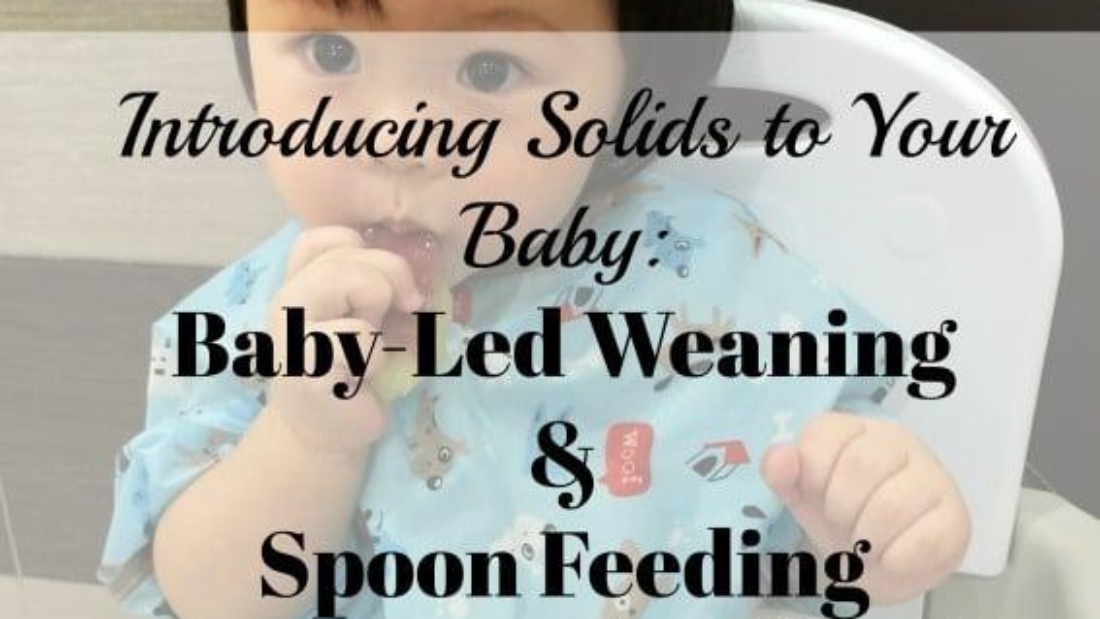When I was a nutrition student, I was taught at school that there is ONLY one way to introduce solids to baby – the traditional “puree, spoon-fed” way.
After being a first-time mom, I was first introduced to the concept of “Baby-Led Weaning” by a friend of mine when my son was around 6 months of age. I had never heard of this before and didn’t know what to think, the questions keep popping in my head “what about the importance of iron-rich foods when first starting solids?” and “what about choking?”. I was so curious and I decided to do some research to learn more about it.
WHAT IS BABY LED WEANING?
The name itself is a bit misleading (I was fooled by it for a while) as we usually think of weaning as the process of stop breastfeeding. Baby-led weaning is DIFFERENT. It is the term used to describe a way of introducing solid foods where babies feed themselves starting about six months of age. Breastfeeding (or formula feeding) continues during this process. For their first solid foods, babies are given larger pieces of soft foods that they can grasp and eat instead of the more Traditional Method of feeding where parents spoon-feed mashed or minced foods to babies. The idea behind baby-led weaning is that the baby can share the same (or similar) foods that the rest of the family is eating and that they sit and participate in the family meal while everyone eats.
TWO APPROACHES TO INTRODUCING SOLIDS TO YOUR BABY
Baby-led weaning and the Traditional Method of introducing solids have similarities. They both recommend you:
- Start introducing solids at about 6 months of age (when baby shows they are ready)
- Let your baby choose how much to eat
- Introduce safe finger foods starting at 6 months
- Encourage eating with the family
- Move toward offering the same foods as the rest of the family
- Never leave the baby unattended while eating
WHAT YOU NEED TO KNOW BEFORE CHOOSING AN APPROACH
Age: Start at 6 months
For both approaches, it is recommended to start at 6 months when your baby can sit up and control her/his head movements. Most babies can grasp larger pieces of food and will try to put them in their mouth at this stage.
Follow Baby’s Hunger and Fullness Cues
With whatever method you choose, practice responsive feeding. This means watching for the cues and clues your baby gives you. Follow your baby’s lead and make sure that she/he decides whether or not she/he eats, what she/he eats (of what you offer), how much she/he eats and how fast or slow she/he eats.
Type of Foods: Offer Iron-Rich Foods as First Foods
Babies need a lot of iron (11 mg/day at 7-12 months of age) and that is why it is recommended that the first foods offered to babies be iron-rich. Please read: Best Started Foods for Baby-Led Weaning
With baby-led weaning it may be more difficult to ensure your baby is getting the iron she/he needs. Some parents will start with vegetables and fruit as first foods because they are easy finger foods. However, these foods don’t have enough iron to meet baby’s needs. Offering iron-rich food at least twice a day will help give your baby the iron she/he needs.
Safety: Avoid Foods that are Choking Hazards
The risk of choking is a concern with infants no matter what method of feeding you use. To minimize the risk, always ensure that your baby is sitting up and facing you when eating, learn about how to avoid/decrease the risk of choking and brush up on your infant first aid/CPR course to help keep your baby safe.
DIETITIAN’S THOUGHTS
Self-feeding usually takes longer than spoon-feeding, so allow time for your baby to eat. Some babies will be better than others at getting food into their mouths and eating it. If you’re trying BLW and find that baby continues to have a hard time, try a mixed approach (TW+FF). Offering some food on a spoon in addition to finger foods may help them meet their energy, iron, and general nutrition needs. It may also help them avoid feeling frustrated if they want to eat but don’t quite have the movements down. I certainly don’t think that you should be made to feel guilty about the way you choose to introduce solids.
If your baby was born early, is not growing well, is developmentally delayed or has a condition that makes chewing or swallowing difficult, then BLW may not be appropriate for them.
Whether you choose to try BLW, traditional approach or a combination of the two, the main goals are:
1) to provide your baby with the nutrients and energy she/he needs
2) to expose her/him to new flavours and texture
3) to help her/him safely learn eating skills in a relaxed environment with no parental pressure or distractions
In the end, the best approach is the one that makes you both feel comfortable and confident. Feeling good about how things are going helps to make the eating experience pleasurable for the whole family.


[…] You might also interested in reading about Introducing Solids To Your Baby: Baby-Led Weaning Vs. Spoon Feeding. […]